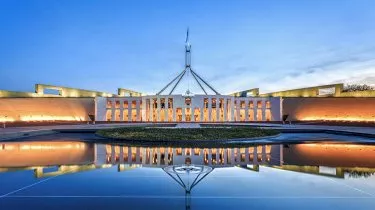Invest
Parliament passes JobKeeper legislation
Both houses of Parliament have approved of the government’s plan to push ahead with the $130 billion JobKeeper package.
Parliament passes JobKeeper legislation
Both houses of Parliament have approved of the government’s plan to push ahead with the $130 billion JobKeeper package.

Announced just over a week ago, the “unprecedented” stimulus aims to prevent firms from laying off employees in order for the economy to bounce back once the threat of COVID-19 has passed.
The plan has been previously described as “Parliament’s Dunkirk moment” by Attorney-General Christian Porter.
“We get the lifeboats out, and we save jobs, and we do it in the simplest clearest guaranteed formula that Parliament can devise,” he had said.
Speaking before Parliament this morning, Prime Minister Scott Morrison said, “Make no mistake, today is not about ideologies.”

“JobKeeper will keep Australians in jobs, and it will keep the businesses that employ them in business, both now and into the future.”
Only the bare minimum number of MPs required to pass the JobKeeper package were present in both houses, in an effort to maintain social distancing requirements.
In the rare show of solidarity that crossed party lines, Opposition Leader Anthony Albanese said, “We come to the Parliament with open hearts and open minds.”
He did concede that as a result, “We are headed for a trillion-dollar debt. It is a bill that will saddle a generation.”
“Even though we have concerns about some elements of the package and would like to see it improved – and we will make suggestions to improve it – we will support the legislation even if our suggestions are not adopted.”
Mr Albanese also congratulated the government on agreeing to the establishment of a Senate Select Committee that will “have an important role in scrutinising in detail the implementation of the package that will be passed through the Parliament”.
That committee will be chaired by Senator Gallagher, the shadow finance minister, with representation from Senator Keneally, Senator Watt, Senator Lambie and two government members, with the Labor leader considering the importance of continued regular meetings of the government.
“It is in the [government’s] interest. It is in the nation’s interest, and I think the public expect it,” he said.
JobKeeper will provide payments of $1,500 per fortnight to an estimated 6 million eligible workers through their employer, with more than 700,000 businesses having already registered to receive such support, as at Tuesday, 7 April.
Payments are expected to begin from May, but will be backdated to the beginning of March.
Speaking to media several days ago, the Prime Minister had said this plan “is going to save tens and tens and tens of thousands of jobs immediately, and hopefully millions more, as we go through the many difficult months ahead”.
The payment is the equivalent of around 70 per cent of the national median wage.
According to Mr Morrison, “For workers in accommodation, hospitality and retail services, some of the most affected by this economic crisis, it equates to a full median replacement wage.”
The Treasury has said that employees will receive a notification from their employer that they are receiving the JobKeeper Payment, with a majority of employees not needing to do anything further, and will, according to the legislation, have the power to vary who is eligible for the scheme.
Eligible employers
The Treasury has noted that employers, including not-for-profits, will be eligible for the subsidy, if at the time of their application:
- their business has an annual turnover of less than $1 billion and they estimate their turnover has fallen or will likely fall by 30 per cent or more; or
- their business has an annual turnover of $1 billion or more (or is part of a consolidated group for income tax purposes with turnover of $1 billion or more) and they estimate their turnover has fallen or will likely fall by 50 per cent or more; and
- their business is not subject to the Major Bank Levy.
Eligible employees:
For employees whose employers meet the above criteria, there are a number of ways they will receive the minimum payment amount of $1,500 per fortnight, before tax.
Full-time and part-time workers, including stood down employees, will be eligible for the JobKeeper Payment, passed on from their employer.
Casual workers will need to have been employed for at least 12 months to be eligible for the program.
There’s a number of ways this payment will be passed on from an employer:
- If your employer pays you $1,500 or more in income per fortnight before tax, the JobKeeper Payment will assist your employer to continue operating by subsidising all or part of your income.
- If your employer would otherwise pay you less than $1,500 in income per fortnight before tax, your employer must pay you, at a minimum, $1,500 per fortnight before tax.
- If you have been stood down, your employer must pay you, at a minimum, $1,500 per fortnight before tax.
More to come.
About the author

About the author


Economy
Navigating the inflation maze: How CFOs can outsmart economic hurdles in Australia
Fresh inflation data have cooled expectations of near-term rate cuts in Australia, intensifying pressure on margins, capital allocation and demand. Rather than wait for monetary relief that may not ...Read more

Economy
Inflation concerns rise as Australia's CPI climbs to 3.8% in October
Australia's latest Consumer Price Index (CPI) figures have sent ripples through the economy, with headline inflation accelerating to 3.8% year-on-year in October, up from 3.6% in September. The data, ...Read more

Economy
October CPI results pose challenges for RBA’s monetary policy stance
In a surprising turn of events, the October Consumer Price Index (CPI) data has raised eyebrows among economists and market strategists, revealing stronger-than-expected inflationary pressures in ...Read more

Economy
Global deal activity declines by 6% amid economic uncertainty, reports GlobalData
In a year characterised by economic turbulence and evolving market conditions, global deal activity has witnessed a notable downturn during the first ten months of 2025. According to GlobalData, a ...Read more

Economy
Australia’s softening labour market puts another RBA cut in play — here’s what business should do now
A four-year high in unemployment has revived expectations the Reserve Bank could deliver another rate cut as soon as November. With quarterly GDP growth running at 0.6 per cent and annual growth at ...Read more

Economy
Rising CPI reinforces RBA’s stance as rate cut expectations remain: State Street
State Street Global Advisors says the Reserve Bank of Australia (RBA) is likely to hold its current policy outlook following the release of September quarter inflation data, which showed an unexpected ...Read more

Economy
NSW SES boosts tsunami preparedness ahead of World Tsunami Awareness Day
As World Tsunami Awareness Day approaches on 5 November, the New South Wales State Emergency Service (NSW SES) is ramping up efforts to enhance tsunami preparedness along the east coastRead more

Economy
Lifesaving Regional Response Strengthened with New NSW SES Vehicles
In a significant boost to regional emergency services, the NSW State Emergency Service (SES) has unveiled 11 new Community First Response (CFR) vehicles, designed to enhance the speed and safety of ...Read more

Economy
Navigating the inflation maze: How CFOs can outsmart economic hurdles in Australia
Fresh inflation data have cooled expectations of near-term rate cuts in Australia, intensifying pressure on margins, capital allocation and demand. Rather than wait for monetary relief that may not ...Read more

Economy
Inflation concerns rise as Australia's CPI climbs to 3.8% in October
Australia's latest Consumer Price Index (CPI) figures have sent ripples through the economy, with headline inflation accelerating to 3.8% year-on-year in October, up from 3.6% in September. The data, ...Read more

Economy
October CPI results pose challenges for RBA’s monetary policy stance
In a surprising turn of events, the October Consumer Price Index (CPI) data has raised eyebrows among economists and market strategists, revealing stronger-than-expected inflationary pressures in ...Read more

Economy
Global deal activity declines by 6% amid economic uncertainty, reports GlobalData
In a year characterised by economic turbulence and evolving market conditions, global deal activity has witnessed a notable downturn during the first ten months of 2025. According to GlobalData, a ...Read more

Economy
Australia’s softening labour market puts another RBA cut in play — here’s what business should do now
A four-year high in unemployment has revived expectations the Reserve Bank could deliver another rate cut as soon as November. With quarterly GDP growth running at 0.6 per cent and annual growth at ...Read more

Economy
Rising CPI reinforces RBA’s stance as rate cut expectations remain: State Street
State Street Global Advisors says the Reserve Bank of Australia (RBA) is likely to hold its current policy outlook following the release of September quarter inflation data, which showed an unexpected ...Read more

Economy
NSW SES boosts tsunami preparedness ahead of World Tsunami Awareness Day
As World Tsunami Awareness Day approaches on 5 November, the New South Wales State Emergency Service (NSW SES) is ramping up efforts to enhance tsunami preparedness along the east coastRead more

Economy
Lifesaving Regional Response Strengthened with New NSW SES Vehicles
In a significant boost to regional emergency services, the NSW State Emergency Service (SES) has unveiled 11 new Community First Response (CFR) vehicles, designed to enhance the speed and safety of ...Read more








